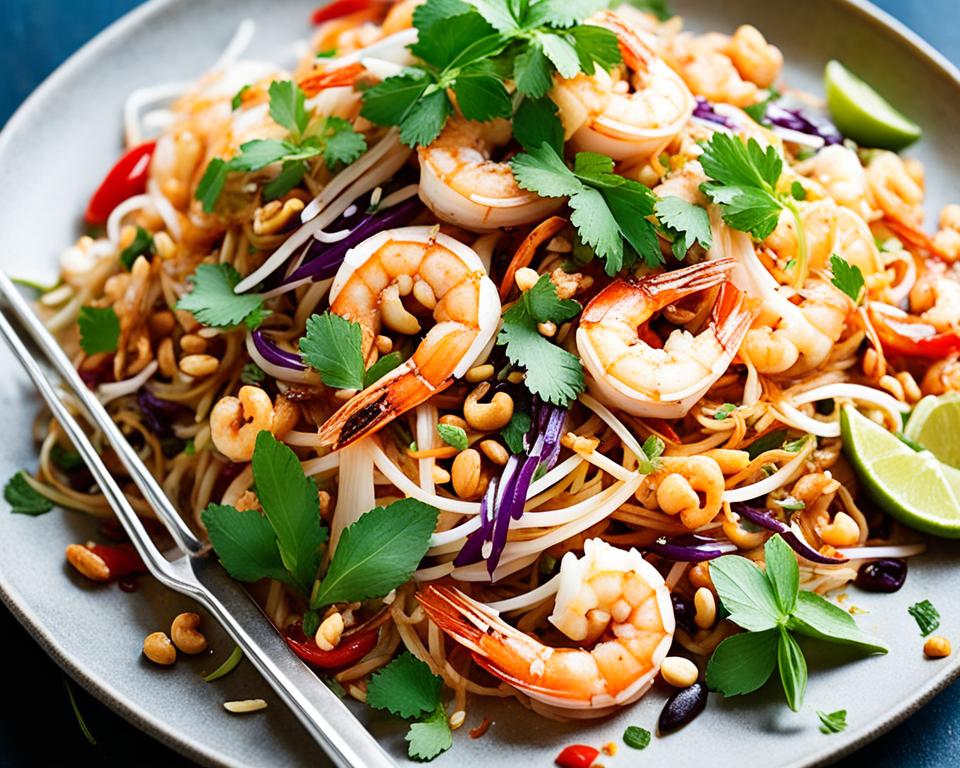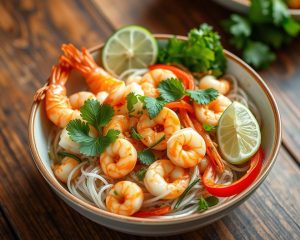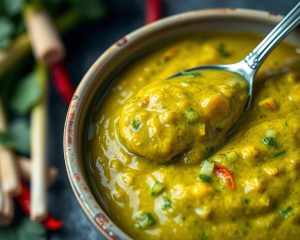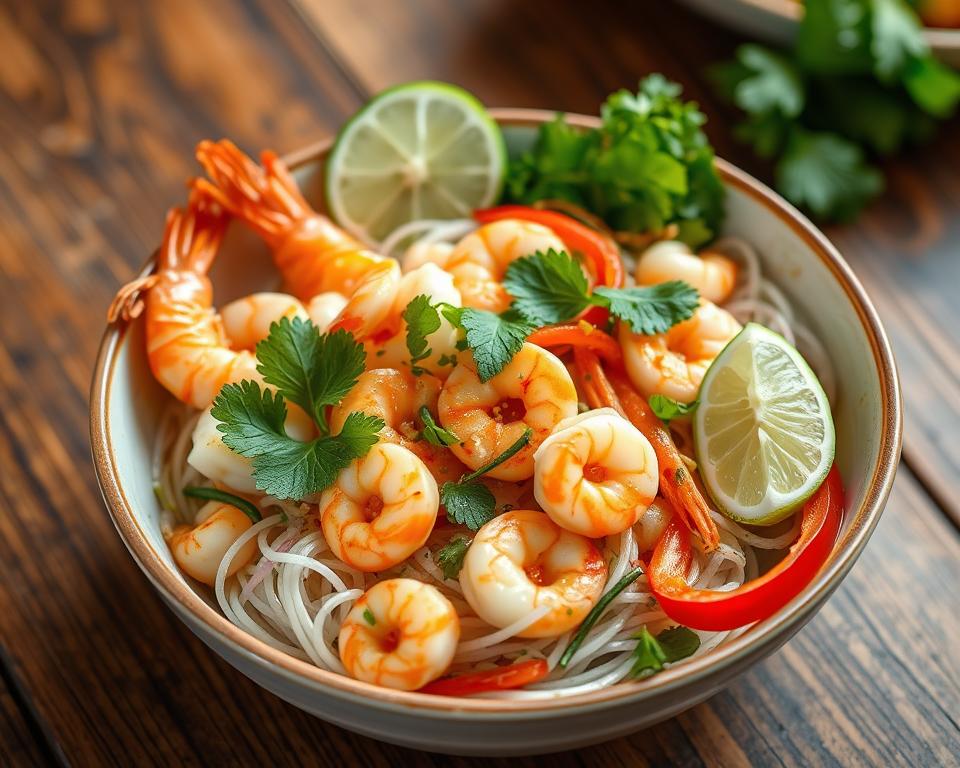Pad Thai is a cherished Thai cuisine classic that has won over people around the globe. It combines various tastes and textures, giving a glimpse into Thailand’s food culture. Let’s dive into its origins, essential ingredients, and how it’s traditionally made in this piece.
From Thailand’s diverse culture, pad thai has become a symbol in the food world. It brings together rice noodles, peanut sauce, bean sprouts, lime, peanuts, and cilantro. This mix not only tastes amazing but also shows a culture rich in flavors.
This dish is all about balancing flavors perfectly. Fish sauce and tamarind paste mix to create a dance of sweet, sour, and savory tastes. Making authentic pad thai is a skill many learn over generations. In this article, we share the secrets to making a flawless plate of this beloved dish.
Read more interesting information at ::thekitchenbookstore
The Origins of Pad Thai Noodles
The beloved pad thai noodles came to be in the 1930s. At this time, Thailand’s Prime Minister wanted to make a dish that shows Thailand’s food culture. Pad Thai combines Chinese stir-fry dishes with the taste of traditional Thai cuisine.
A Blend of Cultural Influences
Chinese immigrants were very important in making pad thai noodles. They had the idea to use rice noodles, a key part of many Chinese dishes. Mixing Chinese cooking with Thai seasonings made pad thai taste unique.
The Role of Chinese Immigrants
Many Chinese immigrants came to Thailand in the early 1900s. They brought their food traditions with them. This influenced what pad thai is today.
“Pad Thai arose from a fusion of Chinese and Thai culinary traditions, incorporating elements of stir-fried noodle dishes from China and the flavors of traditional Thai cuisine.”
Creating pad thai noodles shows how Thailand and China share many cultural ideas. The dish is now a favorite in Thai cuisine because of this history.
Ingredients in Traditional Pad Thai
At the core of a true pad thai noodles plate is a blend of ingredients. These make a beautiful taste harmony. Mainly, rice noodles serve as the starting point for this Thai dish.
The classic pad thai mix includes proteins, veggies, and a flavorful sauce. It often highlights either juicy shrimp or tofu. Veggies like bean sprouts and scallions give a nice crunch.
The special pad thai sauce mixes fish sauce, tamarind paste, and palm sugar. This blend offers a mix of sweet, sour, and umami. The sauce joins all flavors together well.
Finally, crushed peanuts, lime wedges, and cilantro complete the dish. They bring unique textures and tastes. These toppings are a must for the full pad thai experience.
“The key to a truly authentic pad thai lies in the perfect balance of its ingredients, where each element plays a vital role in creating the quintessential Thai taste.”
Whether you know pad thai well or it’s new to you, learning about its ingredients is crucial. This is the first step to real pad thai enjoyment. By appreciating the mix of flavors and textures, you get to taste the true heart of pad thai in each mouthful.
Preparing the Perfect Pad Thai Noodles
The perfect Pad Thai begins with rice noodles, a crucial part of this Thai favorite. To get the right texture, it’s all about preparing and stir-frying these noodles just right.
Soaking and Stir-Frying the Noodles
First, soak the pad thai noodles until they’re soft enough to stir-fry. This step is key for the noodles to absorb flavors and have the perfect chewy yet tender texture.
After soaking, stir-fry the noodles. Use a wok or skillet on high, add a bit of oil, and cook the noodles quickly. This method keeps the noodles from getting mushy and prepares them to be flavored with the pad thai sauce.
Mastering the Pad Thai Sauce
The sauce is the heart of Pad Thai, mixing sweet, sour, and savory perfectly. It’s made from fish sauce, tamarind paste, palm sugar, and more. This blend makes the dish what it is.
Creating the Pad Thai sauce means balancing many flavors correctly. You need to adjust the sauce ingredients carefully to boost the noodles’ taste. A well-made sauce makes Pad Thai truly delicious.
“The secret to making the best Pad Thai is in the perfect balance of the sauce – it’s a dance of sweet, sour, and savory flavors that brings the entire dish together.”
The Art of Balancing Flavors
The key to great pad thai noodles is finding the perfect mix of tastes. This famous Thai dish blends sweet, sour, and savory flavors. Each taste enhances the others, making every bite special.
Sweet, Sour, and Savory Harmony
Making delicious pad thai noodles needs a mix of unique ingredients. You’ll find palm sugar or tamarind for sweetness, and fish sauce or lime juice for sourness. Dried shrimp, roasted peanuts, or egg add the savory touch.
Blending these tastes well makes a dish that sings on your taste buds. The sweet, sour, and savory elements balance each other. This harmony is what makes pad thai noodles so satisfying.
“The perfect pad thai is a study in contrasts, where each flavor plays a crucial role in the overall harmony of the dish.”
Crafting this balance is the sign of a skilled pad thai chef. They tweak the amounts of each flavor to make an unforgettable dish.
Variations and Regional Twists
The core of pad thai remains the same across Thailand. Yet, each region puts its unique spin on the dish. Thai chefs blend local flavors into this well-loved meal.
Northern Thailand’s Khao Soi Twist
In northern Thailand, pad thai gains a unique flavor with Khao Soi curry. This coconut-based dish is full of spices. It creates a special contrast to the traditional noodles.
Southern Thailand’s Seafood Flair
In the south, fresh seafood is a highlight in pad thai. You’ll find shrimp, squid, and crab in this version. The influence of the coast’s plentiful sea life is clear in its flavors.
Northeastern Thailand’s Spicy Twist
Isaan’s pad thai is known for being bold and spicy. It uses chili peppers and fish sauce. This version adds an exciting twist to the dish, perfect for those who love spicy food.
“The beauty of pad thai noodles is how they change across Thailand. Each region adds its special touch to this favorite meal.”
From the north’s Khao Soi to the south’s seafood and Isaan’s spiciness, Thailand’s pad thai varies widely. These differences highlight the country’s rich food culture. It showcases the diverse and creative cooking of its people.
Serving and Presenting Pad Thai Noodles
Serving pad thai noodles is more than just putting food on a plate. It’s about giving people the chance to make it their own. This dish is hot and comes with extra ingredients. Diners can add these to get the taste they love.
Traditional Garnishes and Accompaniments
A plate of real pad thai has many bright parts. You might see:
- Fresh lime wedges to add a refreshing, tangy note
- Crunchy bean sprouts for a textural contrast
- Finely chopped cilantro for a fragrant, herbal touch
- Crushed peanuts to provide a nutty, savory crunch
These toppings let people mix sweet, sour, and savory tastes. That makes the meal even better.
Adding these traditional sides makes pad thai look great. It also lets diners play with the flavors. So, they can enjoy each bite their way.
| Garnish | Flavor Profile | Contribution to Pad Thai |
|---|---|---|
| Lime wedges | Tangy, acidic | Adds a refreshing, bright note to balance the sweetness |
| Bean sprouts | Crunchy, fresh | Provides a textural contrast to the soft noodles |
| Cilantro | Fragrant, herbal | Enhances the overall aroma and freshness of the dish |
| Crushed peanuts | Nutty, savory | Adds a delightful crunch and depth of flavor |
“The presentation of pad thai is as important as the flavors themselves, as it invites diners to engage with the dish and make it their own.”
Pad Thai Noodles: A Street Food Icon
Pad Thai is a well-loved street food icon in Thailand. Vendors all over the country offer their own twists on the dish. The colorful street stalls and food carts give a real taste of pad thai noodles. This shows how much people love it and its place in Thailand’s food history.
The charm of pad thai noodles in Thailand is amazing. You can smell the noodles cooking and see chefs skillfully preparing the dish at night markets and crowded streets. This attracts locals and tourists to enjoy the perfect mix of flavors in a bowl.
Eating pad thai noodles at a street stall is a big part of Thai life. Customers often sit together and talk. The lively atmosphere makes pad thai noodles even more special as a street food favorite.
| Iconic Pad Thai Noodle Stalls | Location | Signature Variations |
|---|---|---|
| Thipsamai Pad Thai | Bangkok | Crispy Pad Thai, Prawn Pad Thai |
| Phahonyothin Pad Thai | Chiang Mai | Egg Pad Thai, Vegetarian Pad Thai |
| Pad Thai Soi Rambuttri | Phuket | Seafood Pad Thai, Pad Thai Talay |
The undying love for pad thai noodles in Thailand is special. It’s not just about the food but the whole experience. The lively cooking, beautiful dishes, and sharing meals make pad thai noodles a must-try tradition.
“The true essence of Pad Thai can be found in the bustling street stalls, where the sights, sounds, and flavors come together to create a truly unforgettable dining experience.”
Nutritional Benefits of Pad Thai
Pad Thai noodles offer more than just a tasty meal. They balance carbohydrates, protein, vitamins, and minerals. This mix makes it a good pick for those watching their health.
A Balanced Meal in a Bowl
Rice noodles in Pad Thai give you lasting energy through complex carbs. Adding chicken, shrimp, or tofu brings protein for a full meal. Toppings like bean sprouts and peanuts add nutrients, fiber, and antioxidants.
| Nutrient | Amount per Serving | % of Daily Value |
|---|---|---|
| Calories | 350 kcal | 17.5% |
| Carbohydrates | 45 g | 15% |
| Protein | 18 g | 36% |
| Fat | 12 g | 18% |
| Fiber | 3 g | 12% |
| Vitamin A | 20% DV | 20% |
| Vitamin C | 15% DV | 15% |
| Calcium | 10% DV | 10% |
| Iron | 8% DV | 8% |
Pad Thai is flexible, suited for many eating needs. You can pick from shrimp, chicken, or tofu, all rich in nutrition.
Enjoy a serving of Pad Thai noodles for a meal that pleases your taste buds and supports your health.
Pairing Pad Thai with Beverages
Pad Thai is a well-known Thai dish with a vibrant taste. It pairs well with several drinks that enhance its flavors. Whether it’s a Thai iced tea or a cold lager, the right drink can make your meal even better. This drink can also balance the dish’s sweet, sour, and salty tastes.
Many beverages go well with pad thai noodles.
- Thai Iced Tea: It’s rich and slightly sweet, perfect with the bold flavors of pad thai for a refreshing mix.
- Lager Beers: Light lagers like Singha or Chang cleanse your palate against pad thai’s strong taste.
- Fresh Fruit Juices: Citrus juices match the sourness, while mango or pineapple juice balances its sweetness.
For a more exotic choice, try coconut water or coconut milk with your pad thai. It brings a creamy, tropical touch to your meal.
| Beverage | Flavor Profile | Pairing Rationale |
|---|---|---|
| Thai Iced Tea | Rich, creamy, and slightly sweet | Provides a refreshing contrast to the bold flavors of pad thai |
| Lager Beers | Crisp and clean | Offers a refreshing counterpoint, cleansing the palate between bites |
| Fresh Fruit Juices | Citrusy, sweet, or tropical | Can complement the sour or sweet notes in pad thai |
| Coconut Water/Milk | Creamy and tropical | Adds a delightful creaminess and tropical element to the dining experience |
Choosing the right drink can make eating pad thai a joy. It creates a perfect mix of flavors and textures. This experience is one you won’t forget.
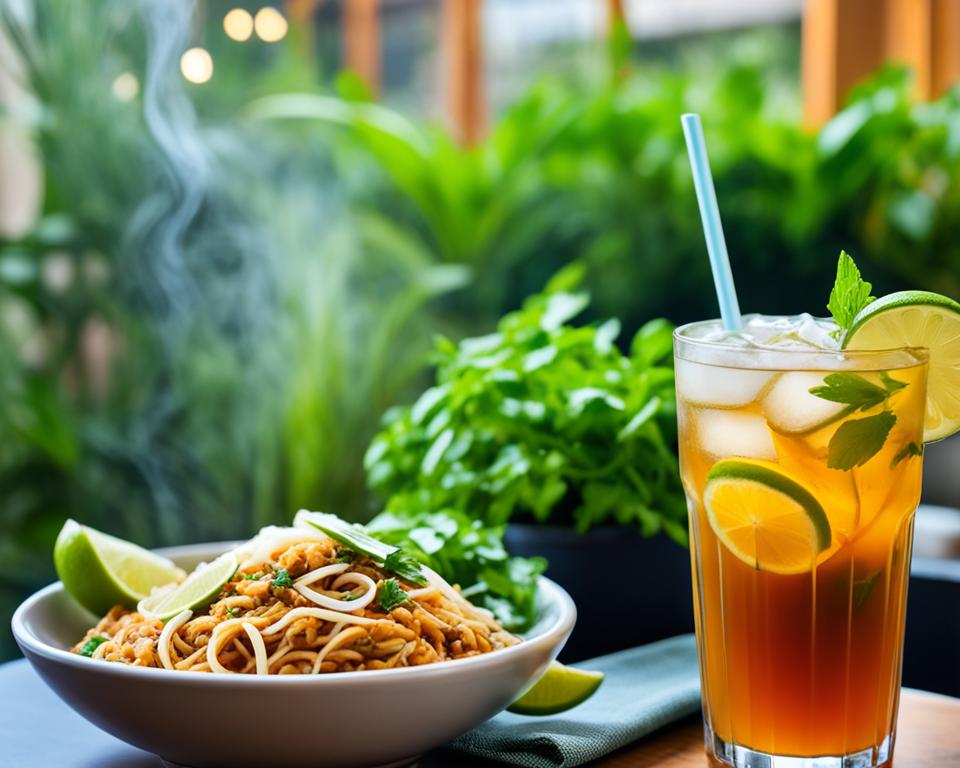
Mastering the Wok Tossing Technique
The art of making real pad thai noodles includes a fascinating skill called wok tossing. This method is crucial for getting the right mix of textures and flavors in the dish. To toss a wok properly, you need to practice and understand the balance of the ingredients well.
Pad thai noodles are cooked in a wok on high heat. Fast tossing mixes the noodles, meat, veggies, and sauce in a circular way. This quick move spreads the tastes, so every mouthful is a perfect mix of sweet, sour, and salty.
- Start by heating the wok over high heat until it’s smoking hot.
- Add a small amount of oil, then quickly toss in the noodles, ingredients, and sauce.
- Using a rapid, circular motion, toss the contents of the wok continuously, keeping the food moving at all times.
- Maintain a high heat throughout the tossing process to create a charred, caramelized flavor on the noodles and ingredients.
- Finish by tossing the pad thai noodles one final time to ensure all the flavors are beautifully integrated.
Getting good at wok tossing means you can keep food moving gently and evenly. This skill makes a dish of pad thai noodles turn out just right. With the diverse textures and flavors in place.
Wok tossing transforms the basic ingredients into a work of culinary art, as the quote says:
“The wok tossing technique is the heart and soul of authentic pad thai noodles. It’s a dance that transforms the simple ingredients into a culinary masterpiece.”
Learning the wok tossing method is key to preparing an excellent pad thai noodles dish. This ensures your meal looks great and tastes like it’s straight from Thailand. Practice and a passion for cooking can help anyone make amazing pad thai noodles at home.
Cultural Significance of Pad Thai
Pad Thai is a famous Thai noodle dish that means a lot more than just good food. It’s a symbol of Thai culture, showing their great history of mixing different flavors. It brings people together over a shared love for its taste and ties to Thailand’s cultural past.
A National Dish of Thailand
In Thailand, Pad Thai is a huge deal. It’s not just another meal; it represents a vibrant food scene that’s famous around the world. This dish stands out as a favorite, making it a top pick for everyone who loves Thai food.
The dish’s roots go back to the early 1900s, where Chinese immigrants brought their noodle and stir-fry skills. Thai cooks then added their own special touch with local ingredients. This fusion made Pad Thai uniquely Thai, blending foreign and local tastes beautifully.
“Pad Thai is not just a dish, it’s a celebration of Thailand’s culinary heritage and a testament to the country’s ability to embrace diverse cultural influences and forge a distinctive national cuisine.”
Pad Thai stands for more than a tasty meal. It’s a sign of pride for the nation and a way to share Thai food with the world. It’s popular across all parts of society, showing its power to bring people closer through food.
Now, Pad Thai is known worldwide, showing the connecting power of food. It highlights the tradition and culture of Thailand, known for rich and diverse dishes.
Vegetarian and Vegan Pad Thai Options
Pad thai noodles is a dish that easily fits a vegetarian or vegan diet. Instead of meat, you can use tofu, mushrooms, or veggies. This change makes Pad Thai dishes suited for many diets.
When making a vegetarian option, use firm or extra-firm tofu. It mimics the chewiness of shrimp or chicken. Marinate the tofu in soy sauce, lime juice, and spices to improve its taste.
Mushrooms are a great alternative for vegan Pad Thai. Types like shiitake and oyster add a deep, savory flavor. They mix well with the dish’s other tastes.
A veggie-filled Pad Thai is another excellent choice. Add carrots, bean sprouts, bell peppers, and snow peas for color and crunch. This makes the meal both delicious and full of nutrients.
| Ingredient | Vegetarian Pad Thai | Vegan Pad Thai |
|---|---|---|
| Protein | Firm or extra-firm tofu | Tofu, mushrooms |
| Vegetables | Carrots, bean sprouts, bell peppers, snow peas | Carrots, bean sprouts, bell peppers, snow peas |
| Sauce | Vegetarian fish sauce, tamarind, palm sugar | Soy sauce, tamarind, palm sugar |
Using these vegetarian and vegan options, you can have true Pad Thai flavor. This way, everyone’s dietary needs are met without sacrificing taste.
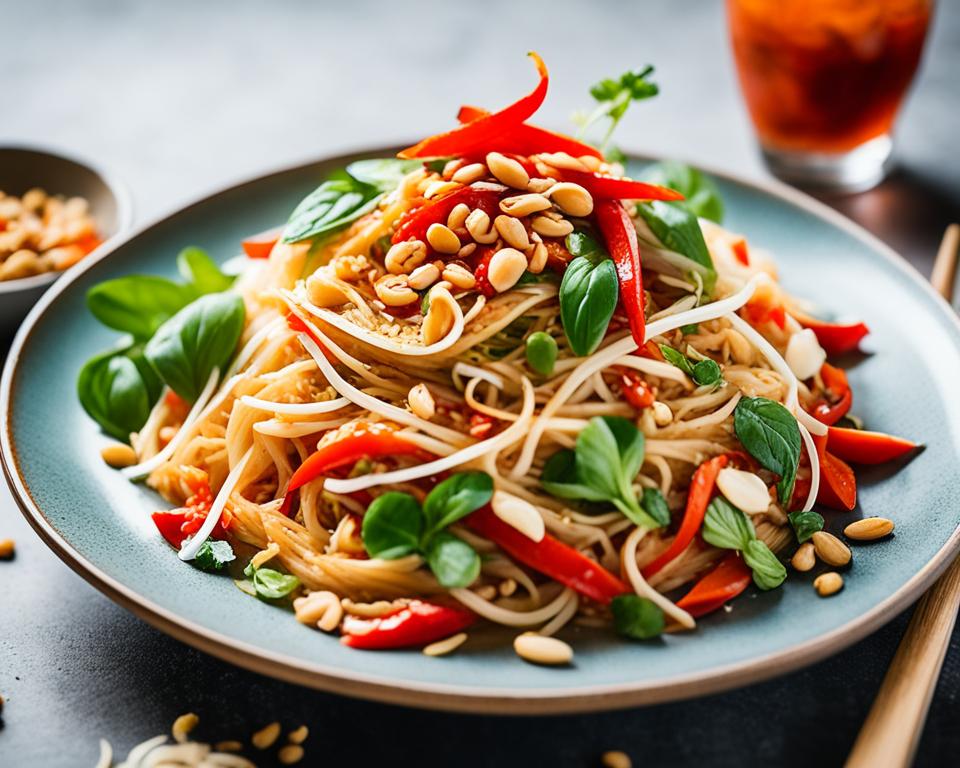
Conclusion
Pad Thai noodles are a well-loved Thai dish that people enjoy all over the world. We looked into its history, main ingredients, and how it’s cooked. This helped us understand its true cultural and culinary value. Whether you try it in a busy market or make it at home, Pad Thai shows the amazing mix of flavors in Thai food.
It blends Chinese and Thai cooking styles, creating a perfect mix of sweet, sour, and salty tastes. We also saw how different areas have their own unique versions of Pad Thai. Yet, its popularity has made it a symbol of Thailand’s food globally.
In the end, Pad Thai is like a bridge to Thailand’s rich food past and its creative present. You can love it as a simple street snack or in a fancy restaurant. This dish always wins people over with its amazing taste. It truly leaves a memorable mark on anyone who tries it.
